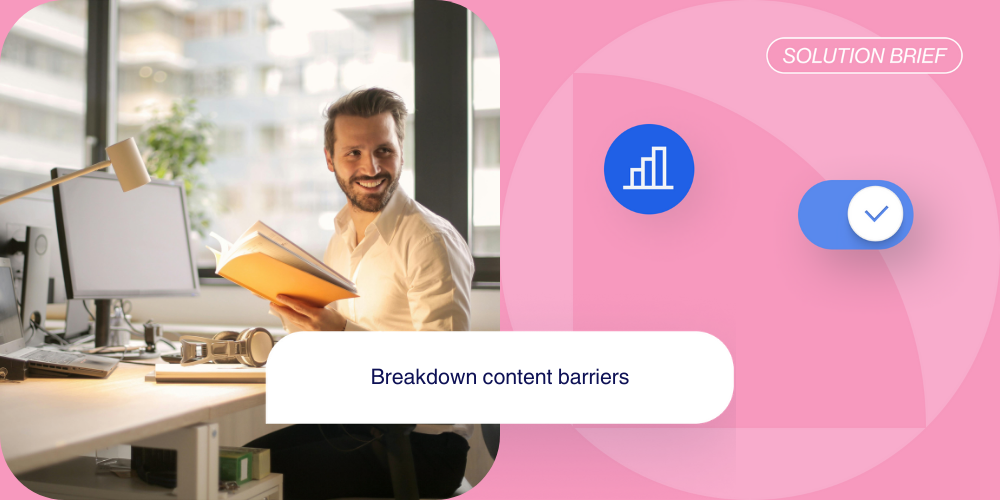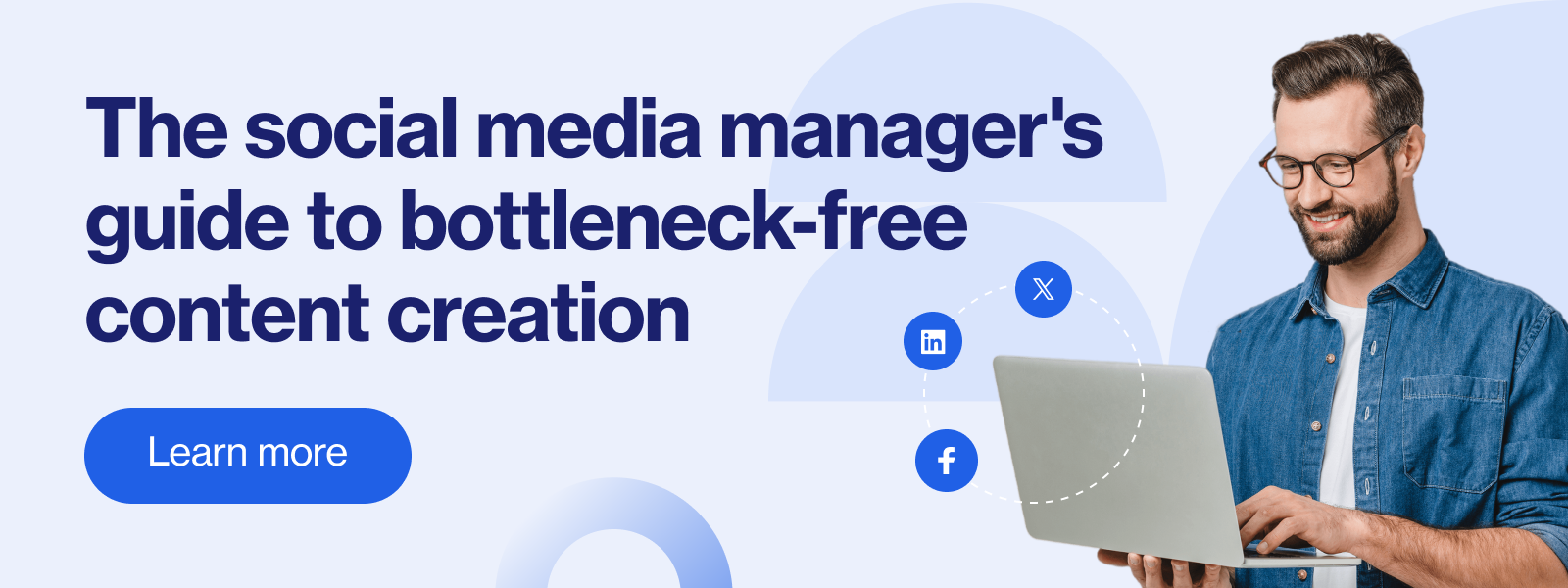
Combine your B2B social and advocacy strategy and overcome content bottlenecks
Suppose you’re a social media content manager juggling the demands of crafting engaging social media content while curating materials for an employee advocacy program. In that case, you know how chaotic things can get. Content creation bottlenecks are a daily reality for many professionals in your shoes—deadlines are missed, approval processes drag on, and employees are left without fresh content to share.
The result? Missed opportunities to engage your audience, decreased employee advocacy participation, and a lot of unnecessary stress.
But here’s the good news: bottlenecks aren’t inevitable. With the right strategies and tools, you can build an efficient content creation workflow that keeps your social channels thriving and your employee advocacy program running seamlessly.
This blog post will highlight the most common bottlenecks in social media and employee advocacy workflows, their root causes, and actionable solutions. And if you’re ready to take it a step further, we’ve got a complete guide—The social media manager’s guide to bottleneck-free content creation—that dives deeper into overcoming these challenges and keeping your content pipeline flowing effortlessly.
The problem: Bottlenecks are stalling your content workflow
Content must be timely, engaging, and consistent for brands to thrive on social media and employee advocacy platforms. But bottlenecks can bring your efforts to a screeching halt.
The challenges content managers face:
- Inefficient approval cycles: Waiting on multiple stakeholders to approve every piece of content slows everything down.
- Overstretched teams: Balancing social media campaigns and employee advocacy content often feels like trying to do two full-time jobs with half the resources.
- Disjointed workflows: Without a centralized system, it’s easy for teams to work in silos, leading to miscommunication and delays.
These challenges affect deadlines, employee morale, brand consistency, and the effectiveness of your advocacy program.
How bottlenecks hurt your social media and advocacy programs
Let’s break down the real-world consequences of content creation bottlenecks:
1. Missed opportunities for engagement
Social media thrives on timeliness. Whether jumping on trending topics or delivering time-sensitive updates, delays in content approvals mean your brand misses out on key opportunities to connect with your audience.
The same applies to employee advocacy. If your employees don’t have fresh, relevant content to share, they’ll disengage from the program, and your advocacy efforts will lose momentum.
2. Inconsistent brand presence
When bottlenecks disrupt your posting schedule, your audience notices. Irregular social media activity erodes trust, while outdated advocacy content makes your program feel irrelevant. A disorganized workflow can lead to inconsistent messaging across platforms, damaging your brand’s authority.
3. Increased stress for content managers and teams
Constantly navigating bottlenecks takes a toll on your team. Content managers spend more time chasing approvals than focusing on creativity and strategy. Employees participating in advocacy programs become frustrated when they need more resources to contribute effectively.
If any of this sounds familiar, you’re not alone. Bottlenecks are a common challenge—but they’re also fixable.
Recommended for further reading
The root cause: Why bottlenecks happen
Content creation workflows for social media and employee advocacy could be more efficient because they rely on outdated processes or tools.
Here are the three main culprits:
1. Inefficient approval processes
- Too many gatekeepers slow down approvals, with content getting stuck in endless feedback loops.
- Miscommunication between stakeholders leads to repetitive revisions and unnecessary delays.
- Without a structured workflow, it’s unclear who has the final say on approvals, adding confusion to the process.
2. Insufficient resources
- Social media and employee advocacy programs require a steady stream of high-quality content—but many teams lack the bandwidth to meet this demand.
- Curating content for advocacy (e.g., third-party articles or thought leadership pieces) is an additional burden, leaving little time for strategic planning or campaign execution.
3. Disconnected workflows
- Teams working in silos often create duplicate efforts instead of leveraging shared resources.
- Without a centralized content library, it’s challenging to repurpose content for both social media and advocacy, leading to inefficiencies and missed opportunities.
The solution: Streamlining workflows with the right strategies
To overcome these bottlenecks, content managers must optimize their social media and employee advocacy workflows. Here’s how:
1. Simplify the approval process
- Identify key decision-makers and reduce the number of stakeholders involved in approvals.
- Use structured workflows with clear stages for feedback and final sign-off.
- Create templates for different types of content and news
- Invest in a centralized platform like Oktopost to manage the approval process in one place, eliminating back-and-forth emails and confusion.
2. Create dual-purpose content
- Develop content with both social media and advocacy in mind. This will allow you to repurpose materials for multiple audiences.
- Curate third-party content to supplement your material and provide employees with various shareable resources.
- Build a shared content library where approved assets are easily accessible for teams and employees.
3. Automate where possible
- Use tools to automate scheduling and publishing, ensuring your social media posts go live at the right time.
- Automate the distribution of advocacy content so employees always have fresh material to share without waiting for manual updates.
- Use data and analytics to identify bottlenecks in your process and refine workflows over time.
How Oktopost can help
Oktopost is a powerful platform designed to address the challenges of managing social media and employee advocacy content. With Oktopost, you can:
- Streamline approvals: Create transparent workflows to track content from creation to final approval.
- Centralize content management: Use Oktopost’s library to store, organize, and repurpose social media and advocacy materials.
- Automate scheduling and distribution: Save time by automating the social media publishing process and seamlessly pushing approved content to your advocacy program.
- Track performance: Monitor the effectiveness of your social media campaigns and employee advocacy efforts in one dashboard, allowing you to refine your strategy.
Oktopost enables content managers to take control of their workflows, eliminate bottlenecks, and focus on creating value for their audience and employees.
Want to learn more? Download the guide.
This blog has touched on some of the biggest challenges and solutions for managing social media and employee advocacy workflows—but there’s so much more to uncover.
Our free guide, “Breaking free from content creation bottlenecks,” dives deep into:
- The root causes of bottlenecks and how they impact your brand.
- Proven strategies to streamline content creation and approval processes.
- How to integrate social media and advocacy workflows for maximum efficiency.
- Real-world success stories from brands that have overcome bottlenecks using Oktopost.
If you’re ready to take your content creation process to the next level, download the guide now and unlock the secrets to bottleneck-free workflows.
Conclusion
Content creation bottlenecks are frustrating, but they’re also fixable. You can transform your content strategy and keep your social media and advocacy programs running smoothly by identifying inefficiencies in your workflows, simplifying approval processes, and leveraging tools like Oktopost.
Don’t let bottlenecks hold your brand back. Download the guide today and start building a content workflow that works for you.



